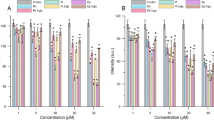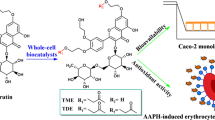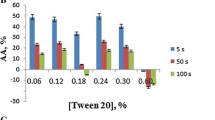Abstract
Two oxygen-transporting proteins known for their immunostimulating and anticancer properties, namely hemocyanin from Helix lucorum (HlH) and hemocyanin from Rapana thomasiana (RtH), have been modified for the first time with rosmarinic acid (RA). We prepared two conjugates RA–HlH and RA–RtH containing 47 and 50 rosmarinic acid residues, respectively. The conformational analysis showed that the secondary structure of RA–HlH is less ordered than that of the native HlH, and for the modified protein we observed a decrease in α-helical structures in the favor of random coils, unordered structures, and aggregates. Calorimetric studies showed an increase in the thermal stability of RA–HlH in comparison with the native HlH which is in agreement with the observed structural changes. On the other hand, the conformation of RA–RtH was very similar to that of the native RtH although some rearrangements in the molecule were found. Interestingly, the modification of RtH with RA resulted in a decrease in its thermal stability. A 48-h in vitro experiment showed that tested in concentrations up to 0.7 mg mL−1 the two modified hemocyanins did not inhibit the cell growth of human fibroblasts.





Similar content being viewed by others
References
Swamy MK, Sinniah UR, Ghasemzadeh A. Anticancer potential of rosmarinic acid and its improved production through biotechnological interventions and functional genomics. Appl Microbiol Biotechnol. 2018;102(18):7775–93.
Li G-S, Jiang W-L, Tian J-W, Qu G-W, Zhu H-B, Fu F-H. In vitro and in vivo antifibrotic effects of rosmarinic acid on experimental liver fibrosis. Phytomedicine. 2010;17:282–8.
Ma Z-J, Hu Y, Wang Y-J, Yang Y, Li X-B, Shi A-C, Xu J-W, Lu Y-B, Lu L, Wang X-X. Proteomics analysis demonstrating rosmarinic acid suppresses cell growth by blocking the glycolytic pathway in human HepG2 cells. Biomed Pharmacother. 2018;105:334–49.
Moon D-O, Kim M-O, Lee J-D, Choi YH, Kim G-Y. Rosmarinic acid sensitizes cell death through suppression of TNF-a-induced NF-jB activation and ROS generation in human leukemia U937 cells. Cancer Lett. 2010;288:183–91.
Berdowska I, Zielinski B, Fecka I, Kulbacka J, Saczko J, Gamian A. Cytotoxic impact of phenolics from Lamiaceae species on human breast cancer cells. Food Chem. 2013;141:1313–21.
Paluszczak J, Krajka-Kuzniak V, Baer-Dubowska W. The effect of dietary polyphenols on the epigenetic regulation of gene expression in MCF7 breast cancer cells. Toxicol Lett. 2010;192:119–25.
Parisi OI, Malivindi R, Amone F, Ruffo M, Malanchin R, Carlomagno F, Piangiolino C Nobile, Pezzi V, Scrivano L, Puoci F. Safety and efficacy of dextran-rosmarinic acid conjugates as innovative polymeric antioxidants in skin whitening: what is the evidence? Cosmetics. 2017;4(3):28.
Ge L, Zhu M, Li X, Xu Y, Ma X, Shi R, Li D, Mu C. Development of active rosmarinic acid-gelatin biodegradable films with antioxidant and long-term antibacterial activities. Food Hydrocoll. 2018;83:308–16.
Ali M, Keppler JK, Coenye T, Schwarz K. Covalent whey protein–rosmarinic acid interactions: a comparison of alkaline and enzymatic modifications on physicochemical, antioxidative, and antibacterial properties. J Food Sci. 2018;83(8):2092–100.
Coates CJ, Decker H. Immunological properties of oxygen-transport proteins: hemoglobin, hemocyanin and hemerythrin. Cell Mol Life Sci. 2017;74(2):293–317.
Gatsogiannis C, Hofnagel O, Markl J, Raunser S. Structure of mega-hemocyanin reveals protein origami in snails. Structure. 2015;23:93–103.
Becker MI, Arancibia S, Salazar F, Del Campo M, De Ioannes A. Mollusk hemocyanins as natural immunostimulants in biomedical applications. In: Huynh G, Duc T, editors. Inmmune response activation. London: InTechOpen; 2014.
Nahas MR, Rosenblatt J, Lazarus HM, Avigan D. Anti-cancer vaccine therapy for hematologic malignancies: an evolving era. Blood Rev. 2018;32(4):312–25.
Miles D, Roché H, Martin M, Perren TJ, Cameron DA, Glaspy J, Dodwell D, Parkerh J, Mayordomo J, Tresi A, Murray JL, Ibrahim NK, the Theratope® Study Group. Phase III multicenter clinical trial of the sialyl-TN (STn)-Keyhole limpet hemocyanin (KLH) vaccine for metastatic breast cancer. Oncologist. 2011;16(8):1092–100.
Román JJM, Del Campo M, Villar J, Paolini F, Curzio G, Venuti A, Jara L, Ferreira J, Murgas P, Lladser A, Manubens A, Becker MI. Immunotherapeutic potential of mollusk hemocyanins in combination with human vaccine adjuvants in murine models of oral cancer. J Immunol Res. 2019;2019:Article 7076942.
Liao J, Pan B, Liao G, Zhao Q, Gao Y, Chai X, Zhuo X, Wu Q, Jiao B, Pan W, Guo Z. Synthesis and immunological studies of β-1,2-mannan-peptide conjugates as antifungal vaccines. Eur J Med Chem. 2019;173:250–60.
Shen X, Orson FM, Kosten TR. Anti-addiction vaccines. Med Rep. 2011;3:20.
Guncheva M, Paunova K, Ossowicz P, Rozwadowski Z, Janus E, Idakieva K, Todinova S, Raynova Y, Uzunova V, Apostolova S, Tzoneva R, Yancheva D. Modification of Rapana thomasiana hemocyanin with choline amino acid salts significantly enhances its antiproliferative activity against MCF-7 human breast cancer cells. RSC Adv. 2015;5:63345–54.
Guncheva M, Todinova S, Uzunova V, Idakieva K, Raynova Y, Ossowicz P, Janus E, Tzoneva R. Destabilization of β-hemocyanin from Helix pomatia in presence of choline amino acids results in improved cell specificity and cytotoxicity against human breast cancer. ChemistrySelect. 2019;4:11460–6.
Guncheva M, Idakieva K, Todinova S, Stoyanova E, Yancheva D. Folate-conjugated Helix lucorum hemocyanin—preparation, stability, and cytotoxicity. Z Naturforsch C J Biosci. 2020;75(1–2):23–30.
Guncheva M, Idakieva K, Todinova S, Stoyanova E, Yancheva D. Biophysical properties and cytotoxicity of feruloylated Helix lucorum hemocyanin. Acta Chim Slov. 2020;1:1. https://doi.org/10.17344/acsi.2019.5400.
Velkova L, Dimitrov I, Schwarz H, Stevanovic S, Voelter W, Salvato B, Dolashka-Angelova P. Structure of hemocyanin from garden snail Helix lucorum. Comp Biochem Physiol B. 2010;157:16–25.
Idakieva K, Parvanova K, Todinova S. Differential scanning calorimetry of the irreversible denaturation of Rapana thomasiana (marine snail, Gastropod) hemocyanin. Biochim Biophys Acta. 2005;1748:50–6.
Bradford M. A rapid and sensitive method for the quantitation of microgram quantities of protein utilizing the principle of protein-dye binding. Anal Biochem. 1976;72:248–54.
Lai JY, Ma DH. Glutaraldehyde cross-linking of amniotic membranes affects their nanofibrous structures and limbal epithelial cell culture characteristics. Int J Nanomed. 2013;8:4157–68.
Guncheva M, Todinova S, Yancheva D, Raynova Y, Idakieva K. Thermal stability and secondary structure of feruloylated Rapana thomasiana hemocyanin. J Therm Anal Calorim. 2019;138:2715–20.
Shnyrov VL, Mateo PL. Thermal transitions in the purple membrane from Halobacterium halobium. FEBS. 1993;324(2):237–40.
Kong J, Yu S. Fourier transform infrared spectroscopic analysis of protein secondary structures. Acta Biochim Biophys Sin. 2007;39(8):549–59.
Mosmann T. Rapid colorimetric assay for cellular growth and survival: application to proliferation and cytotoxicity assays. J Immunol Methods. 1983;65:55–63.
Acknowledgements
The financial support of the Bulgarian National Science Fund (Project: ДКOCT 01/27) is gratefully acknowledged.
Author information
Authors and Affiliations
Corresponding author
Additional information
Publisher's Note
Springer Nature remains neutral with regard to jurisdictional claims in published maps and institutional affiliations.
Electronic supplementary material
Below is the link to the electronic supplementary material.
Rights and permissions
About this article
Cite this article
Guncheva, M., Todinova, S., Yancheva, D. et al. Rosmarinic acid-conjugated hemocyanins: synthesis and stability. J Therm Anal Calorim 142, 1903–1909 (2020). https://doi.org/10.1007/s10973-020-09738-0
Received:
Accepted:
Published:
Issue Date:
DOI: https://doi.org/10.1007/s10973-020-09738-0




